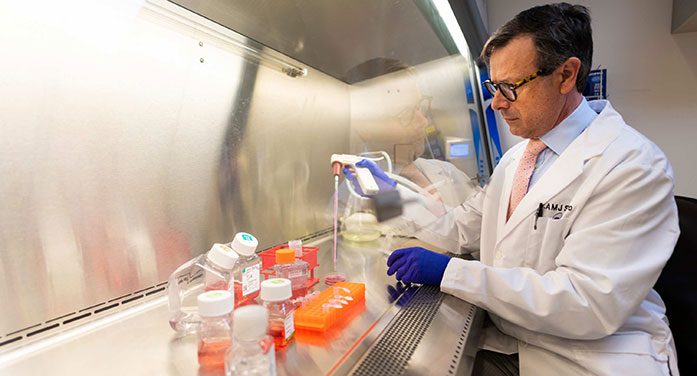
James Shapiro leads the team that developed the revolutionary Edmonton Protocol for islet cell transplants, which has proven successful in improving quality of life for people with hard-to-control diabetes over the last 20 years. (Photo: John Ulan)
After 20 years of perfecting their technique, the team behind the largest islet transplant program in the world reports the procedure is a safe, reliable and life-changing treatment for people with hard-to-control diabetes.
In results published recently in The Lancet Diabetes & Endocrinology, the researchers report on patient survival, graft survival, insulin independence and protection from life-threatening low blood sugars for 255 patients who have received a total of more than 700 infusions of islets at the University of Alberta Hospital over the past two decades.
“We’ve shown very clearly that islet transplantation is an effective therapy for patients with difficult-to-control Type 1 diabetes,” says James Shapiro, professor of surgery in the Faculty of Medicine & Dentistry, Canada Research Chair in regenerative medicine and transplant surgery, and lead of the team that developed what has become known as the Edmonton Protocol. “This long-term safety data gives us confidence that we are doing the right thing.”
Canada’s Stem Cell Network recently announced nearly $3 million in funding for the next step in the research – a project to manufacture and transplant insulin-producing cells from a patient’s own blood.
 Peter Senior |
 Braulio Marfil-Garza |
“This 20-year data shows really strong proof that cell-based therapies can deliver a meaningful and transformative impact for people with diabetes,” says Peter Senior, professor of endocrinology and metabolism, Charles A. Allard Chair in Diabetes Research and director of the Alberta Diabetes Institute.
“We are delivering something which all other treatments for diabetes don’t deliver – there’s a comfort, a predictability, a stability to blood sugar levels that don’t exist with anything else.”
Islets are clusters of cells that produce insulin, a hormone that allows the body to control the flow of energy from food, storing the excess after meals and releasing it to allow the body to function between meals. In Type 1 diabetes, the immune system mistakenly destroys the cells within islets so patients have to take insulin by injection. Patients with hard-to-control or “brittle” diabetes face life-threatening low or high blood sugars and long-term complications.
Between March 1999 and October 2019, 255 patients received islet transplants by infusion into their livers. Seventy per cent of the grafts survived for a median time of nearly six years. The researchers reported that a combination of two anti-inflammatory medications given during the first two weeks following transplant significantly increased long-term islet function.
The transplant recipients have to take lifelong immunosuppression drugs, which in some cases lead to skin cancer or infection, but most such complications were not fatal during the study period. Twenty-five of the patients died due to heart or kidney failure, suicide or unknown causes. While the researchers did not have a direct control group for comparison, they report this is a similar survival rate to that seen in people with complicated Type 1 diabetes.
Seventy-nine per cent of the transplant recipients were able to stop taking insulin after two or more islet infusions and a median time of 95 days following the first transplant. Sixty-one per cent were still insulin-independent a year later, 32 per cent at five years and eight per cent after 20 years, the researchers reported. While most patients had to resume taking insulin injections, the doses were usually much smaller than their original needs and their diabetes control was better.
“Being completely free of insulin is not the main goal,” says Shapiro. “It’s a big bonus, obviously, but the biggest goal for the patient – when their life has been incapacitated by wild, inadequate control of blood sugar and dangerous lows and highs – is being able to stabilize. It is transformational.”
| RELATED CONTENT |
| I have diabetes. Here’s why I’m glad I live in Alberta By Gillian Rutherford |
| A Canadian path to a regenerative cure to Type 1 diabetes By Pat Beechinor |
| Rethinking type 2 diabetes By Jan Hux |
Edmonton is the world’s largest islet transplant program, but such transplants are now also carried out in other Canadian cities, Switzerland, France, Australia and the United Kingdom. Shapiro hopes the results will build confidence in the procedure in places where it is only available on an experimental basis, such as the United States.
“I think looking at this kind of data will encourage scientists, clinical communities and governments to support and explore the possibility of broader availability of islet transplantation,” he says.
Braulio Marfil-Garza, first author of the paper and a PhD candidate under Shapiro’s supervision, will continue the research through a clinical fellowship in Type 1 diabetes and islet transplantation. Originally from Mexico, he hopes to one day bring the treatment to patients in his home country.
“My dream would be to work together with Dr. Shapiro and the team in the future to replicate what they have achieved here in Edmonton,” he says. “There’s no one doing islet transplantation or this type of research in Mexico. I am confident that we can change the lives of many patients.”
Marfil-Garza will try to identify predictors for which patients are most likely to have successful transplants. The key is likely the autoimmune system that causes Type 1 diabetes in the first place, according to Senior.
“With better technologies, we may be able to look at people’s immune system more precisely and say, ‘Is there something about your genetics and your T cells which are just more aggressive?’” Senior explains. “That might give us clues as to ways to mitigate those risks as well.”
Shapiro credits the patients, organ donors, Alberta Health Services, a large team of clinicians, radiologists, scientists and experts in islet cell extraction, along with support from the governments of Alberta and Canada, for the success of the program.
“I’m exceedingly proud of the team that’s accomplished this,” Shapiro says. “We couldn’t have achieved all of that without this big team working together, hand in hand.”
Shapiro will continue to focus on finding a more plentiful supply of islet cells to replace the current reliance on deceased donors. Human trials have already shown success using stem cells programmed to produce insulin. Trials have just started to transplant cells that have been gene-edited to make them invisible to the immune system.
“Islet transplant as it exists today isn’t suitable for everybody, but it shows very clear proof of concept that if we can fix the supply problem and minimize or eliminate the anti-rejection drugs, we will be able to move this treatment forward and make it far more available for children and adults with Type 1 and Type 2 diabetes in the future,” Shapiro says.
| By Gillian Rutherford
Gillian is a reporter with the University of Alberta’s Folio online magazine. The University of Alberta is a Troy Media Editorial Content Provider Partner.
The opinions expressed by our columnists and contributors are theirs alone and do not inherently or expressly reflect the views of our publication.
© Troy Media
Troy Media is an editorial content provider to media outlets and its own hosted community news outlets across Canada.

